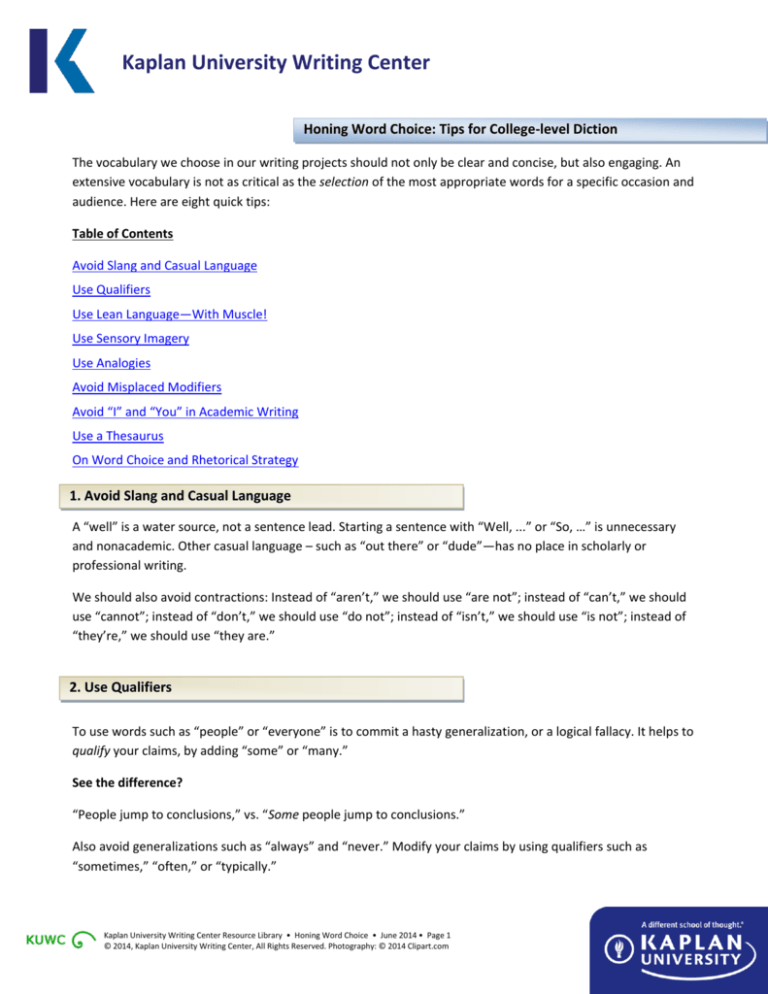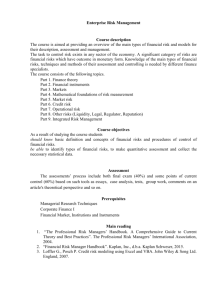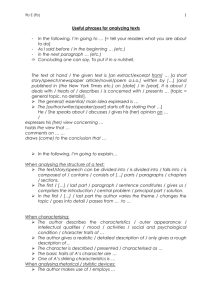
Kaplan University Writing Center
Honing Word Choice: Tips for College-level Diction
The vocabulary we choose in our writing projects should not only be clear and concise, but also engaging. An
extensive vocabulary is not as critical as the selection of the most appropriate words for a specific occasion and
audience. Here are eight quick tips:
Table of Contents
Avoid Slang and Casual Language
Use Qualifiers
Use Lean Language—With Muscle!
Use Sensory Imagery
Use Analogies
Avoid Misplaced Modifiers
Avoid “I” and “You” in Academic Writing
Use a Thesaurus
On Word Choice and Rhetorical Strategy
1. Avoid Slang and Casual Language
A “well” is a water source, not a sentence lead. Starting a sentence with “Well, ...” or “So, …” is unnecessary
and nonacademic. Other casual language – such as “out there” or “dude”—has no place in scholarly or
professional writing.
We should also avoid contractions: Instead of “aren’t,” we should use “are not”; instead of “can’t,” we should
use “cannot”; instead of “don’t,” we should use “do not”; instead of “isn’t,” we should use “is not”; instead of
“they’re,” we should use “they are.”
2. Use Qualifiers
To use words such as “people” or “everyone” is to commit a hasty generalization, or a logical fallacy. It helps to
qualify your claims, by adding “some” or “many.”
See the difference?
“People jump to conclusions,” vs. “Some people jump to conclusions.”
Also avoid generalizations such as “always” and “never.” Modify your claims by using qualifiers such as
“sometimes,” “often,” or “typically.”
Kaplan University Writing Center Resource Library • Honing Word Choice • June 2014 • Page 1
© 2014, Kaplan University Writing Center, All Rights Reserved. Photography: © 2014 Clipart.com
Kaplan University Writing Center
Back to Table of Contents
3. Use Lean Language—with Muscle!
Edit wordiness, reduce prepositions, eliminate passive “be” or “have” verbs; but offer
strong, concrete details.
Example: “Individuals with the privilege to have the option for quality education do not
have to work so hard.”
Revision: “For some people, quality education is a given, while others struggle to obtain
current textbooks and useful equipment.”
Figure 1. Lean language includes
specific words and concrete details.
Photography © 2014 Clipart.com
4. Use Sensory Imagery
Use language that evokes images for the reader. Descriptive writing that causes pictures of concrete objects or
people will help readers invest in our topic. Word-pictures appeal to the emotions, and those pathos appeals
are what persuade readers. One of the best ways to help our audience “see” what we mean is to use sensory
details, i.e., evoke the five senses: sight, sound, touch, smell, taste. For a great example of sensory
description, read E.B. White's essay, “Once “More to the Lake” (1941); here is one effective passage:
Outside, the road was tarred and cars stood in front of the store. Inside, all was just as it had always been,
except there was more Coca Cola and not so much . . . sarsaparilla. We would walk out with a bottle of pop
apiece and sometimes the pop would backfire up our noses and hurt.
What specific smells, tastes, or feelings do you enjoy in E. B. White’s imagery?
5. Use Analogies
Analogies are useful in explaining something abstract. An analogy uses a
familiar person, place, or thing to illustrate something similar but more
complex.
An example would be using the analogy of household plumbing, to explain how
the heart works (arteries carry blood in and out, just as plumbing uses in/out
valves). Plumbing is something we see every day, while the heart is hidden and
mysterious. Using the analogy of something concrete, we can help our readers
understand a more difficult concept.
Back to Table of Contents
Kaplan University Writing Center Resource Library • Honing Word Choice • June 2014 • Page 2
© 2014, Kaplan University Writing Center, All Rights Reserved. Photography: © 2014 Clipart.com
Figure 2. Analogies help readers
understand how abstract concepts are
similar to more everyday objects and
interactions.
Photography © 2014 Clipart.com
Kaplan University Writing Center
6. Avoid Misplaced Modifiers
Writers use adjectives to add details about a noun or a pronoun. Sometimes, though, those adjectives or
details (called “modifiers”) are misplaced in the sentence, so that readers are confused about which noun or
pronoun those details concern. Example: “Bob visited an outpatient clinic suffering from urinary tract
infections.”
(Was it Bob or the clinic that had the infections?) It is easy to adjust the misplaced modifier, by putting it closer
to the noun or pronoun that it describes: “When Bob suffered from urinary tract infections, he visited an
outpatient clinic.”
The best reason to avoid 1st-Person pronouns (I/me/my/mine) is that academic readers often do not care
about the writer’s personal opinion, as much as they are interested in what the experts have said about an
issue. Readers look for the conclusions that can be drawn from our scholarly research and analysis.
7. Avoid “I” and “You” in Academic Writing
Nor do readers want us to talk directly to them, using “you” or “your.” First, those pronouns inject a familiarity
into the writing, which some readers may resent. Second, using “you” in our writing often results in a How-To
essay, as though we are presuming to teach readers a new method or a way of doing something better. Third,
using “you” often puts readers on the defensive (we can appreciate this when we think about our own
reactions when someone suggests to us, “You should . . .”).
There are a few alternatives we writers may draw on, to avoid the “I/You” pronouns.
First, we might use 3rd-Person plural pronouns (“they,” “them,” “their”). Third-Person
plural is much easier than using the awkward “he or she” phrase over and over.
Another alternative is to use generic terms, such as “people” (or “researchers” or
“executives” or “shoppers” or “Americans” or any other collective noun which
can be partnered with the pronoun “they”).
Finally, in some cases, the pronoun “we” is a useful alternative to “I” or “you.”
Especially when we are arguing that readers must take some kind of corrective
action, it is a smart rhetorical strategy to include ourselves as part of the
problem. Thus, instead of claiming that our readers should be better parents,
we might write: “We parents need to become more watchful of our teens’
time spent on the computer.”
Back to Table of Contents
Kaplan University Writing Center Resource Library • Honing Word Choice • June 2014 • Page 3
© 2014, Kaplan University Writing Center, All Rights Reserved. Photography: © 2014 Clipart.com
©20
13
Jupit
erim
ages
Figure 3. Uncle Sam may want YOU, but it is
wise to generally avoid the second person in
academic writing.
Illustration © 2014 Clipart.com
Kaplan University Writing Center
8. Use a Thesaurus
When writers find themselves using the same word over and over, a Thesaurus gives us new options. For
example, a writer might be arguing that X is a mistake. There are only so many times the word “mistake” can
be used, before readers become bored and irritated. Using the Thesaurus, which is organized like a dictionary
but offers synonyms instead of definitions, we can look up “mistake,” to find these alternative words:
error, blunder, misunderstanding, MISJUDGMENT
Those words will help add interest to the essay. But since “Misjudgment” is capitalized in the Thesaurus, we
refer to that listing and we find: miscalculation, foregone conclusion, bias, narrow-mindedness, pedantry,
misconception, dogmatic, bigotry, and many more options. Some of these synonyms for “mistake” may
appropriately tilt the claim that the writer wants to make, but some of these words might also put readers on
the defensive. Writers must be selective with word choices and always be thinking of the audience’s potential
response.
On Word Choice and Rhetorical Strategy
Honing our vocabulary and selecting appropriate terms are two of the main ingredients of effective rhetoric.
As Aristotle defined rhetorical composition, in Ancient Greece, the professional should search for the most
appropriate terms for the particular audience on a specific occasion.
Figure 4. Much like a game of Scrabble, word choice influences
the intended audience and the purpose of writing. Photography
© Dan Taylor, Flickr:
http://www.flickr.com/photos/dantaylor/359399174/.
CC License: https://creativecommons.org/licenses/by/2.0/
Back to Table of Contents
Kaplan University Writing Center Resource Library • Honing Word Choice • June 2014 • Page 4
© 2014, Kaplan University Writing Center, All Rights Reserved. Photography: © 2014 Clipart.com








